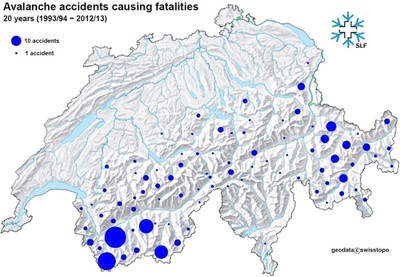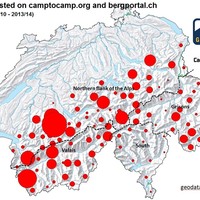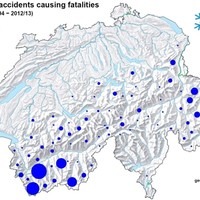Regional patterns of avalanche accidents in Switzerland
Fusionner des documents
Attention, les photos associées ne seront pas supprimées et deviendront orphelines.
Si vous souhaitez juste modifier le titre ou les documents associés (ex : déplacer une sortie vers un autre itinéraire), il suffit de modifier le document.
Si ce document est un doublon comportant des photos, demandez @Modo_Topo_FR de fusionner les doublons pour déplacer les photos sur le document conservé.
Articles
Points de passage
Itinéraires
Livres
Sorties
Rapports incidents/accidents
Utilisateurs
Maybe you still remember the news from the many tragic avalanche accidents which occurred last winter in the Lower Valais. And maybe you have also noted: this is a pattern which seems to occur in many winters.
A look at the map with the locations of the fatal avalanche accidents in the Swiss Alps confirms this.

But what are the reasons for this clustering of accidents in Valais and Grisons? Is it a consequence of high backcountry touring frequency in these regions? Or are there other reasons for a higher avalanche accident risk in these regions?
To answer these questions, we needed to know the number of ski-/snowboard- or snow-shoe tourers in the backcountry. As there is no data on who goes backcountry touring when and where, we investigated the condition reports posted on the two popular mountaineering networks www.bergportal.ch and www.camptocamp.org
We looked at the date and the location for which a report was posted. All up, there were 15’000 geo-referenced reports during the five winters 2009/10 to 2013/14. While this may seem like a large number, it is only a small proportion of the actual backcountry users and may have an unknown bias leading to potentially misleading conclusions. Therefore, we compared the usage pattern with a survey concerning the Swiss avalanche bulletin (conducted in 2014). This comparison showed that the posted backcountry condition reports provide a plausible picture of regional backcountry usage. However, we would like to emphasize to be careful when interpreting this regional distribution.

Would you like to know more about the results of this study? Then follow one of these links:
english: http://www.slf.ch/praevention/lawinenunfaelle/unfaelle_regional/index_EN
german: http://www.slf.ch/praevention/lawinenunfaelle/unfaelle_regional/index_DE


Commentaires
Ce contenu est sous licence Creative Commons BY-SA 3.0
Les images associées à cette page sont disponibles sous la licence spécifiée sur le document d'origine de chaque image.
Imprimé le 7 août 2025 04:21


